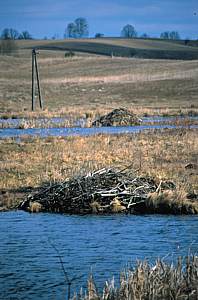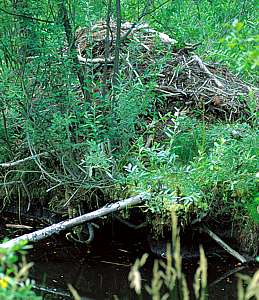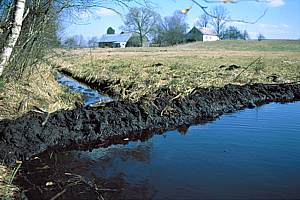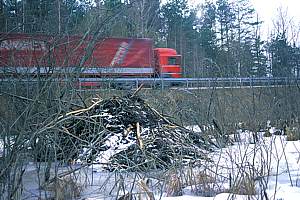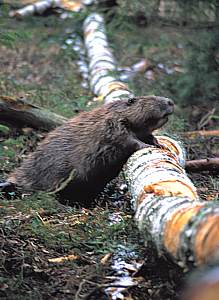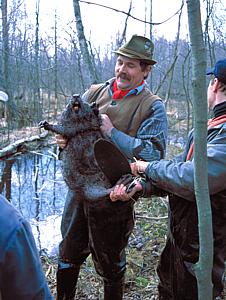|
BEAVERS
|
||||||||||||
Text:
|
History of beavers in Poland
The European beaver is a native animal of Poland. In the early Middle Ages it used to be one of the most common animals in our country. For many centuries the beaver was very highly valued game. Polish black beaver coats were considered by foreign markets to be the most beautiful. Beaver meat was sought-after by medieval monasteries and magnate courts, which were obliged by numerous fasts. Some believe that in those times beavers were considered to be fish due to their tails covered with pseudo-scales, and fish dishes were thought meatless. Since the oldest times, the fragrant gland secretion, so called "castoreum drops" (castoreum), was considered to be the cure for all ailments, and described in books: "when used in very large dishes it has an exciting effect, increases the warmth and draft of the skin, as well as the pulse. Castoreum drops are used to treat the following ailments: hysteria, hypochondria, exhausted nerve sense, brain and spinal narrow oddities, nerve seizures, headaches, faintings, heart poundings, migraines and chest cramps, lower stomach nuralgia, and by obstetricians when delivering babies".
During the reign of the Piast dynasty, the privilege of beaver hunting was reserved for dukes only. The ruling duke maintained a group of beaver hunters. It was led by a dominus castorum - beaver master, who was the superior of beaver hunters - venatore castorum. The beaver hunters were responsible for breeding and taking care of beavers within the duke's territory. They were released from the subordination to voivodes and castellans, so that they could fulfill their duties without any obstacles. The present names of villages, such as Bobrowniki or Bobrowa are derived from the names of the duke's hunting services stationing there.
Although in those times beavers were under special care of Polish kings and dukes, in 13th century their number began to decrease. Intensive hunting led to the slow withdrawal of these animals from the area of Poland, a tendency which was also noticed in the area east of the Vistula river. The 15th century marked the fall of the hunting monopoly of our rulers. It was the beginning of a period when hunting privileges resulted from land ownership. The development of grange economy, and the decreasing area of natural terrain resulting from it, led to the endangerment of the existence of beavers. Numerous legal acts, providing the protection of beaver sites, did not improve the situation. The many centuries of hunting and the transformation of natural beaver settlements had led to almost total extinction of this species. Beavers are assumed to have become almost completely extinct within the current boundaries of our country in the second half of 19th century.
In the reborn Poland, this dying species became strictly protected by means of the decree from 1919 and the environment protection act from 1934. After the long-term decrease in the number of beavers, a slight growth was noticed during the period between the two world wars. In 1928 the population of beavers was estimated at 235 individuals, to reach 400 by 1939. The second world war, as well as the shifting of borders, decreased the population of beavers to about 130 individuals in 1958 and 270 individuals in 1966. Only few beaver sites existed then, located by the Pasłęka river in Masurian Lakeland, and by the Czarna Hańcza and Marycha rivers in Suwalskie Lakeland.
The many years of beaver species protection contributed to the gradual increase of their number. In 1968 the population was estimated at 300 individuals, in 1972 at 350, and in 1975 already at 500 individuals. Natural migrations and the introduction of animals imported from the Soviet Union, as well as the efforts of both the scientists from Polish Science Academy and the hunters from the Polish Hunting Association, aimed at the restoration of this species, enabled the creation of small, local beaver sites. They were the beginning of the current population of about 18 thousand beavers in our country. The successful restoration of the numerical force of beavers in Poland is mainly the result of the commitment and determination of the now deceased enthusiast and researcher of these animals - Wirgiliusz Żurowski. In 1976 he began the realisation of "The Active Protection of the European Beaver in Poland" programme. The programme was conducted by the Experimental Department of the Polish Science Academy in Popielnie and the Polish Hunting Association. The main guidelines of the project were: the protection of the existing sites and the introduction of beavers in favourable places all around the country. A concept of species restitution was developed, which included: the technology of catching, transporting and settling of the animals, as well as of monitoring the existence of the newly created populations. The plan also assumed a systematic introduction of biotechnical endeavours in beaver sites, aiming at maintaining the good state of water and food base.
The protection and active restitution led to an increase in beaver population, spreading it over nearly the whole area of the country. Almost half of the national population of beavers (approx. 10 000 individuals) now inhabit the territory of north-eastern Poland. The beavers have "saturated" almost all environments in this region. Cases of beavers inhabiting small field water bodies, drainage ditches, and even settling within the close proximity of transportation routes made these animals abrasive towards human economy, making some people consider them a pest. Flooding meadows and fields, gnawing trees, destroying dikes and embankments or even undermining the transportation routes tend to place beavers in the position of a victim. That is why intervention catches of beavers in the most problematic areas are conducted. The animals are then transferred to uninhabited terrains.
The beavers restitution programme is carried out by the District Management of the Polish Hunting Association in Suwałki. Until the year 2000, 1100 individuals were caught and transferred to different places located in almost the whole country. Polish beavers were also introduced in Germany, Austria, the Netherlands, Slovakia and England. The basic objective of the catches and restitution of the European beaver is the restoration of the previously eradicated species in the native fauna. Rebuilding the population of beavers is a long-term process. It can be said now that the long lasting programme of active protection of beavers in Poland has been fully successful. However, broadening the beavers' territory in our country by adding areas which are still inaccessible by means of natural migration is yet to be accomplished.
|
|||||||||||
|
|
|
